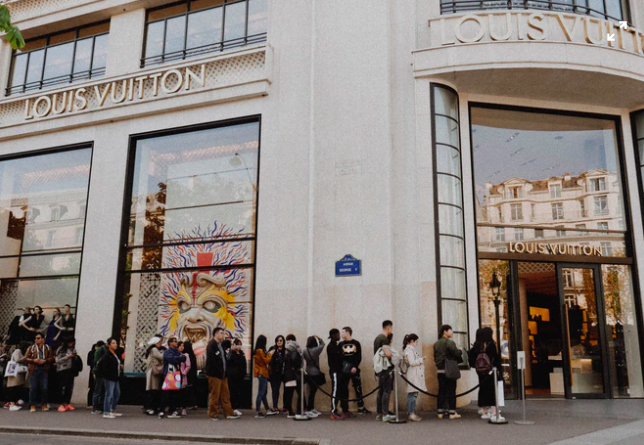What does it mean that luxury brands attracting and targeting younger shoppers?
Louis Vuitton flagship store in Paris, France. Image Credit: Unsplash/Melanie Pongratz
To market well, a brand must truly understand its target audience, and as some brands have learned, there may come a time when they have to shift their target audience to encapsulate a rising generation. Millennials and Gen Z consumers are an increasingly powerful demographic segment. These generations combined total over 60 percent of the global population, and they eschew most generalizations categorizing them as a ubiquitous group of “young people.” So how are brands supposed to keep up with the latest trends of the largest demographic? Marketing professionals have to be on their toes, ready to adapt to the fickle nature of internet popularity and “cancel culture.”
Alicia Vikander stars in Louis Vuitton book club social media campaign, 2020. Image Credit: LVMH
For anyone who follows Fashion Week and top fashion houses, it’s clear that the past several years have been a turning point. Suddenly fashion gatekeepers like high-fashion magazine editors, top designers, and stylists, have less power over what’s in and what’s out. We’re witnessing a period of fashion democratization prompted by social media, online boutiques by lesser known and indie designers, and the rise of fast fashion, which despite its negative environmental impacts allows for clothes to be bought seasonally and at lower prices. Brands like Gucci, Chanel, Dior, Saint Laurent, and others have all had to adapt their messaging and campaigns to fit the times. Their public relations teams have also been busy, often cleaning up PR nightmares that Millennial and Gen Z audiences are less willing to accept than the generations before them. (See: Prada’s racist keychains and Gucci’s blackface sweaters.)
In an attempt to modernize, many brands have adopted, or at least decided to project, core values that Millennials and Gen Z hold dear, including environmentalism, women’s empowerment, inclusivity, and authenticity. Brands like Louis Vuitton have started collaborating with celebrities who appeal to teenagers, like Youtuber and influencer Emma Chamberlain, known for her laidback, casual attitude and her tendency to overshare. The addition of Chamberlain to the Louis Vuitton persona stretches it beyond those who it has opted for in the past like the more reserved, indie darlings Michelle Williams and Arizona Muse. The famous fashion house has also begun sitting K-pop stars front row, tapping into international K-pop fervor, who are especially popular amongst American teens. This sort of marketing makes sense given that the United States and Asia compose 24 percent and 30 percent of LVMH Group’s revenue share worldwide respectively.
For example, Louis Vuitton Artistic Director Virgil Abloh published a colorful, quirky short animation/video hybrid film promoting the LV Men’s Spring-Summer 2021 collection. As one Youtube commenter says, the watching experience “feels like being on LSD,” a far cry from the stoic, glamorous campaigns of the early 2000s. Louis Vuitton has also incorporated innovative creative campaigns, for example the genre-crossing Fictional #LVPrefall20 Book Club which stars celebrities reading lines from romance and sci-fi novels while donning LV looks.
Scarlet Johansson stars in a prime example of the aloof, highly sexualized early-2000s Louis Vuitton campaigns. Image Credit: LV Fall/Winter 2004
Also departing from traditional advertising, Gucci recently started a comic strip Instagram campaign in which they commissioned 24-year-old artist Melek Zertal to make artwork depicting characters wearing Gucci clothes and discussing gender identity and fluidity, highlighting a collection that is “a curated selection... designed by Alessandro Michele that defy traditional stereotypes, celebrating liberty and self-expression.”
Cashing in on memes, social justice movements, and internet stars has become a way to keep the attention of generations who are often criticized for their short attention spans. Brands are now making catchy, unpredictable, and outlandish campaigns to seize views and clicks online, something which they hope will translate into revenue and long term brand loyalty.
“Cashing in on memes, social justice movements, and internet stars has become a way to keep attention...”
Social media advertising and digital marketing are the way of the present and future. These luxury brands tap into the media’s versatile nature. While traditional print advertising in fashion magazines are fixed and meant to remain on a glossy page forever, Instagram allows brands to act more like real people do, responding to comments, quickly publishing statements about current events or consumer criticism. Social media advertising gives brands an approachable platform, democratizing brands whose intimidatingly chic storefronts once kept out those who felt like they didn’t belong there. The youthification of luxury brands seems to correlate with their sales growth rate, suggesting that their flexible, inclusive campaigns are succeeding in attracting customers. These brands are proving that they can have their cake and eat it, too, by maintaining the high-end aura of exclusiveness from past decades and simultaneously promoting new brands values and enticing younger consumers with more radical, artistically adventurous advertisements.
By: Kathleen Sharp



